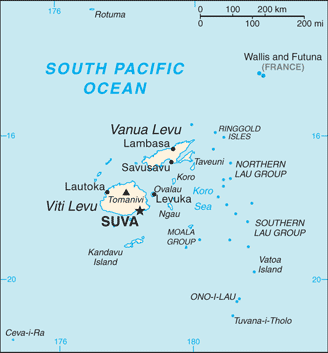Oceania > Fiji: Weather, Map, Costs and Travel Guide

Fiji : When and where to go?
Click on a city for complete climate and weather tables
| Town | Jan | Feb | Mar | Apr | May | June | July | Aug | Sept | Oct | Nov | Dec |
| Suva |  |  |  |  |  |  |  |  |  |  |  |  |
Fiji: Climate & Weather
The climate is divided into two major seasons: from November to April, the rainy season, with high humidity and precipitation, especially between December and early April; The dry season or Fijian winter, from May to October, where there is little rain, mild temperatures and less or no cyclones.
June and September correspond to the high season due to the school holidays in Australia and New Zealand, with therefore prices rising.
It is better to travel to Fiji in May or October to enjoy good climatic conditions without the presence of the crowd.
Weather today

Rain
Wind: 4 km/h
Precipitation forecast: 5,4 mm
> Full report and 7-days forecast
Data updated at 11:40 (local time)
At that time, the weather was:
 30 °C / Partly Cloudy
30 °C / Partly Cloudy
Fiji: Map

Sponsored links
What to do in Fiji
The city of Suva will seduce you with its old and attractive buildings and monuments in the port area, its lively waterfront, artisan stalls in the city center, its cafes and its municipal market. There are also nightclubs and modern bars that will welcome the fans of the nocturnal festival.
Navala is a village lost in the Nausori Highlands, with the traditional architecture, probably one of the most astonishing of Fiji: its constructions indeed meet the criteria of ancestral techniques with braided bamboos, thatched roofs, ropes made of vegetable fibers. A real journey through time.
Sawa-I-Lau, a limestone island, unlike those in the vicinity which are volcanic, has caves where one can admire engravings and paintings whose meaning and origin is unknown, as well as the date when they were conceived. One penetrates by swimming under the water, with a guide: reserved to the traveler in cold blood!
Attend a meke evening: traditional songs and dances, local dishes, walkers on embers.
Visit the natural parks, such as Colo-i-Suva, and meet the multicolored parrots, waterfalls amid thick forests and natural pools.
Fiji: The basics
The local currency is the Fijian dollar.
To get to Fiji, you will fly to Nadi International Airport.
Travel to the archipelago will take place either by airplane by the inland route, or by bicycle to quietly discover some villages, the ferry to go from one island to the other, the bus to get around The main islands. On Viti Levu and Vanua, the car or the motorcycle are very convenient and the road network is correct. It is also possible to find taxis in the main cities.
Health: Take precautions to protect yourself from mosquitoes, and keep your immunizations up to date. Avoid drinking at the tap outside the big cities.
Safety: There is no particular danger if you follow the usual precautions.
Budget: plan a fairly substantial budget, especially for accommodation, you can hardly go below 100 € per day, unless you sleep in dormitory. A meal at the local restaurant will cost you around 15 €.
Shopping: there is a nice local craft, especially pottery and traditional fabrics.



